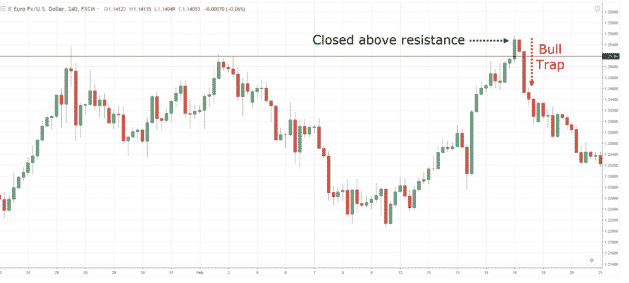What Is A Bull Trap?
False signals in the investment industry are known as bull traps and they refer to a declining trend in a stock, security or index that many thought would continue increasing.
The shift traps investors that bought stock when there was a strong buy signal and can be the leading cause of losses from long positions.
There is an opposite to a bull trap, and it is called a bear trap – it occurs when traders fail to press a decline below a breakdown level.
Traders can lower their chances of being caught by bull traps through seeking validation following a breakout through various technical indicators.
What Does A Bull Trap Indicate To Investors?
Although many breakouts are succeeded by strong moves higher, the stock many times quickly reverses its direction.
As mentioned above, these are colloquially known as ‘Bull Traps’, as the investor who purchased the breakout is trapped in the deal.
Traders can avoid bull traps by keeping their eyes out for confirmations following a breakout.

Image credit: Trading With Rayner
A trader may potentially seek a higher than normal volume and bullish candlesticks on their graph before an outbreak.
Other things to look for are a retracement that respects the breakout level.
This helps to confirm that the price of the security is more than likely to increase.
How To Handle Bull Traps?
Becoming trapped in a bull trap can be a frustrating experience so it is important to recognize the warning signs before investing – now, this is easier said than done.
Warning signs can consist of various behaviors in the market such as low volume breakouts – if this is the case then it is best to exit the trade as soon as practically possible.
Setting up stop-loss orders can be useful when these circumstances unfold, most importantly when the market is moving quickly.
Through this, you avoid letting your emotions dictate how you trade.
One of the best ways to avoid getting caught is to avoid late entries when it comes to investing in a trend.
A trend that has been continuously increasing is a potential sign of a bull trap, but not always.
Investors need to mitigate their risks and the longer an uptrend has traveled, the increased likelihood that a trap will form.
The advice is simple, don’t trade if it’s too good to be true – an uptrend cannot continue forever.
Can You Trade A Bull Trap?
It is possible to trade in bull traps and one of the most successful methods to do so is after a trend change downwards occurs.
Traders will use the knowledge which they have learned over countless years to identify patterns in the graph and short the stock in accordance with the patterns.
It is their hope that these stocks will then drop significantly – earning them a hefty yield in the process.
That is by no means an extensive how-to when it comes to trading a bull trap as one could write an entire thesis on the topic – but it serves as an outline on the general methodology of doing so.
Disclaimer: The information above is for educational purposes only and should not be treated as investment advice. The strategy presented would not be suitable for investors who are ...
more


